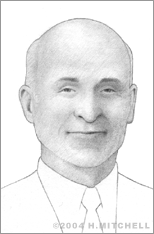George Nissen
Blairstown, Iowa native George Nissen invented a device loved by tumblers, athletes, adults, and children around the world – the trampoline. He holds more than 40 patents related to sports and fitness and has been a tireless promoter of the trampoline and its myriad uses throughout his life.
Born in 1914, Nissen began training in gymnastics as a child, tumbling on his junior high school tumbling team and a local YMCA team when he was in high school. At the Y, he also became adept at diving. These experiences followed him to circus performances that he attended with his family. There he saw the trapeze artists fly through the air, dropping at the end of an act into safety netting that would send them rebounding up into somersaults or other stylish moves. Nissen realized that a similar setup for gymnasts would allow them to perform complex moves like that too, similar to the moves that divers do, except that they would be able to rebound again and again and do more and more tricks.
At 16 years old, Nissen finished high school and set out to develop a bouncing apparatus. Working in his parents’ garage using steel materials that he found at a junkyard, he built a rectangular frame with a piece of canvas stretched across it. While in college at the University of Iowa, he built his first successful rig and brought it to a summer camp, where he and his friends held jobs as camp counselors. It was an instant hit. Nissen was sure he could commercialize it.
Meanwhile, he began competing for his college in gymnastics and was a three-time winner of the intercollegiate national championship. He completed his bachelor’s degree in business in 1937. Shortly thereafter, he and two friends began a traveling acrobatics act called the Three Leonardos. Using Nissen’s bouncing machine, they performed in Texas and in Mexico, and it was there that Nissen learned of the Spanish word for diving board: el trampolin. He registered “Trampoline” as a trademark for his bouncing rig.
The Three Leonardos became popular attractions at school assemblies and used these opportunities to introduce people to the trampoline and attract interest in it. Orders began coming in, slowly at first. Nissen soon had his own company. When World War II began, resources were scarce and orders were scarcer. But he thought this might also be an opportunity. He began pitching his trampolines as training tools for the military. He convinced officials that this device could help parachutists, pilots, and divers in particular to help them learn to physically control themselves and orient themselves in space. He sold more than 100 trampolines, most of them with an improved design using nylon instead of canvas.
In 1943, Nissen joined the Navy. After the war, he incorporated his business, the Nissen Trampoline Corporation, and began heavily promoting the trampoline. National “rebound tumbling” competitions began to take place in 1947. He married Annie, a Dutch acrobat, in 1950 and established a branch of his company in England in 1956. He traveled all over the world to promote the sport of rebound tumbling and watched the trampoline market grow. Soon there were more than 50 manufacturers of devices similar to his.
Nissen created games incorporating the trampoline such as Spaceball, which became very popular in the 1960s. He also broadened his product line, including gymnastic equipment such as balance beams and parallel bars. He acquired a number of patents on improvements to these types of items. His company was sold and eventually ceased to exist in the 1980s, but he continued to invent, with creations such as the Bunsaver Air Cushion, an inflatable cushion designed for spectators to use on the bleachers at sporting events, and the Laptop Exercycle for passengers to use for exercise while traveling on long airplane flights.
Nissen himself was the best example of the health benefits of his product. A gymnast and athlete all his life, he could still do handstands into his 80s and yoga headstands in his 90s. Niessen died in 2010 at the age of 96.


